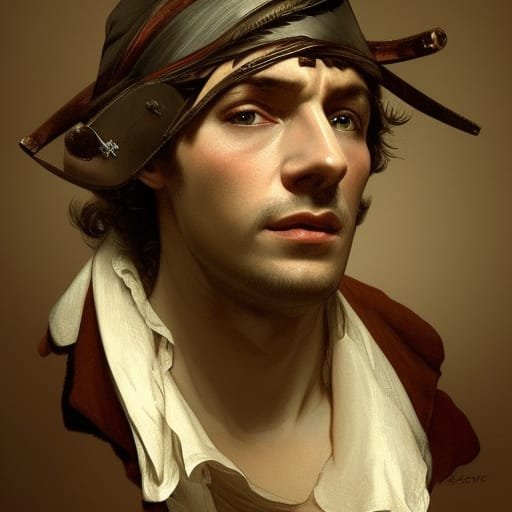The French Revolution was a period of radical social upheaval and political change from 1787 to 1799. It redefined the nature of political power and completely changed the relationship between rulers and their subjects.
The French Revolution laid down the foundation of liberal democracy with its fundamental principles of liberty, equality and fraternity, inspiring movements for universal suffrage and the abolition of slavery.
It was one of the biggest revolutions of all time, with many leaders from the French political class acting as idols for citizens to follow as the face of the revolution.
The three main leaders of the French Revolution were Georges-Jacques Danton, Napoleon Bonaparte, Maximilien Robespierre and Jean-Paul Marat. They played a crucial role in the movement alongside other leaders such as Napoleon Bonaparte and Marquis de Lafayette and were pivotal in its success
Let’s take a look at three key figures of the French Revolution:
Georges Danton

Birth: October 26, 1759
Death: April 5, 1794
Georges Danton was a French lawyer, born on October 26, 1759, to an attorney Jacques Danton and Marie Camus. He was one of the three main leaders of the French Revolution.
Known for his ability to make efficient decisions, Georges Danton dominated his colleagues to become the leader of The Cordeliers Club. He was well-liked by the people for being easily accessible and generously lenient and was involved in multiple powerful political groups in France.
Georges Danton played a crucial role in the success of the revolution as he was involved in the storming of the Bastille. In April 1793, Georges Danton was made the first President of the Committee of Public Safety. However, he did not hold the position for long and was kicked out in July after changing his mind about the use of force as the Reign of Terror began.
Despite being considered a hero under the Third Republic, he became entangled in a financial scandal involving the French East India Company alongside his friends in March 1794 due to his criticism of the Committee of Public Safety.
Georges Danton was charged with conspiracy to overthrow the government and leniency toward the enemies of the Revolution. He was arrested on March 30, 1794, given a mock trial and guillotined on April 5, 1794.
Many historians have described him as “the chief force in the overthrow of the French monarchy and the establishment of the First French Republic”.
Jean-Paul Marat

Birth: May 24, 1743
Death: July 13, 1793
Born on May 24, 1743, in the Prussian Principality of Neuchâtel(now a part of Switzerland), Jean-Paul Marat was a French journalist and politician during the French Revolution.
He was a radical voice who published his views through pamphlets, newspapers and his periodical L’Ami du to vent hatred of people in power during the early stages of the French Revolution.
Despite his papers being outlawed, Jean-Paul Marat continued to write in secret. His writings were known for their fierce and uncompromising tone, inspiring the common citizens of France to revolt against the monarchy.
Jean-Paul Marat wrote about the King, the marquis de Lafayette (French aristocrat and military officer) and the king’s financial advisor, Jacques Necker.
However, his life came to an unfortunate end as he was assassinated on July 13, 1793, while taking a bath by Charlotte Corday, a loyalist to the crown. He soon became a revolutionary martyr for the French citizens and Montagnards faction of the Jacobins.
Jean-Paul Marat was immortalised by the famous Parisian painter Jacques-Louis David in his renowned painting The Death of Marat.
Maximilien Robespierre

Birth: May 6, 1758
Death: July 28, 1794
Maximilien Robespierre was one of the most controversial and influential figures of the French Revolution, perhaps the most important. He was a member of the Jacobin Club, and Constituent Assembly.
He also championed the cause of universal manhood suffrage and the abolition of French involvement in the Atlantic slave trade.
The rise to power of Maximilien Robespierre began after he went to Versailles to attend the meeting of the Estates-General. He was made the Committee of Public Safety leader in July 1793 after Georges Danton was kicked out.
Maximilien Robespierre became a controversial figure after he started the Reign of Terror with the help of the Committee on Public Safety. During that period, more than 300,000 people were arrested, 17,000 executed and a significant number died in the prisons.
The exponential increase in power of Maximilien Robespierre and his supporters worried his allies and enemies after he was elected the head of the National Convention.
Like the other two main leaders of the French Revolution, Maximilien Robespierre’s life also came to an untimely demise after he was arrested alongside 23 of his followers and guillotined on July 27, 1793.
Special Mentions
Napoleon Bonaparte
Birth: August 15 1769
Death: May 5, 1821
Napoleon Bonaparte was a legendary military leader and political leader who rose to prominence during the French Revolution. He was the leader of the 1799 coup and went on to become the Emperor of the French twice.
Olympe de Gouges
Birth: 7 May 1748
Death: 3 November 1793
Olympe de Gouges was a French playwright and intellectual who later became a politician. She is considered the pioneer of feminism for challenging the male authority in the Declaration of the Rights of Woman and of the Female Citizen in 1791. She was executed by guillotine for crimes against the revolutionary government on November 3, 1793.
Marquis de Lafayette
Birth: September 6, 1757
Death: May 20, 1834
Marquis de Lafayette was a French nobleman who led the French forces assisting the patriots in the American Revolution. He was a liberal man dedicated to liberty and was a staunch opponent of slavery.
He favoured a constitutional monarchy and organised a national guard to protect the Revolution from the king. Marquis de Lafayette is often dubbed The Hero of the Two Worlds” for his accomplishments and contribution to revolutions in France and America.
